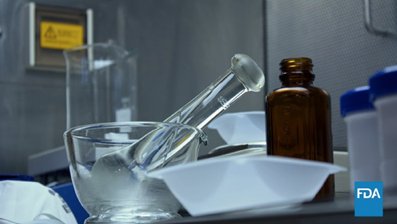Compounded drugs serve an important medical need for patients who can’t use an FDA-approved medication. In today’s #FDA #SUNDAYTWEETORIAL, I’m going to talk about what FDA is doing to preserve access to appropriately compounded drugs while protecting patients from serious risks. 

In drug compounding, ingredients are combined, mixed or altered to create a sterile or non-sterile medication tailored to a patient - such as those with an allergy who need a drug without a certain dye or a child who can’t swallow a tablet and needs medicine in a liquid form. 

But compounded drugs, which aren’t FDA-approved, may pose serious risks if not produced properly, potentially resulting in contamination or medications that do not possess the strength, quality or purity they are supposed to have bit.ly/2G7IpjB 

In 2012, contaminated compounded steroid drugs were injected into patients in multiple states. Hundreds of people developed fungal meningitis and other infections, and scores died. 

The outbreak illuminated the need for improved compounding practices, more robust oversight, close federal/state collaboration, and a clear legal framework with tools for FDA to address unlawful compounding practices.
Also apparent was the need to better define and regulate compounding facilities acting as large-scale drug manufacturers, outside FDA’s routine oversight. Congress responded with the Drug Quality & Security Act (DQSA). bit.ly/2QaoRR0 

The DQSA enabled FDA to fully implement & enforce existing law about traditional compounders – licensed physicians/licensed pharmacists in state-licensed/federal facilities - and created a new compounding category, outsourcing facilities. bit.ly/2xoV01R
Pharmacy compounders produce medicines for an individual patient with a valid prescription and states continue to have day-to-day oversight. 

Outsourcing facilities may engage in larger-scale, nationwide distribution with the potential to expose more patients to risks. They must meet FDA’s CGMP requirements, be inspected by FDA according to a risk-based schedule, report adverse events and meet other conditions.
Since 2013, we have made great strides in DQSA implementation through robust inspection and enforcement, policy development, oversight and stakeholder outreach. We have also convened advisory committee meetings to get scientific advice and collaborated with the states. 

FDA continues to learn of cases of patient illnesses & death due to improperly compounded drugs. In 2017, at least 43 patients developed vision loss after injection in the eyeball with a compounded combination of a steroid and and anti-infective drug during cataract surgery. 

We pursue a risk-based & for-cause approach to inspections and enforcement, focusing on sterile compounding. Since 2013, there have been 201 for-cause inspections (adverse events, product quality, facility concern), 272 surveillance inspections and 188 follow-up inspections. 

Sterile compounding requires a controlled environment with filtered air, controlled pressure, particle monitors, special equipment & protective clothing. We continue to observe sterile compounding outside controlled environments & in egregious conditions w/ mold growth & vermin. 

The vast majority of compounding inspections since Oct. 2012 have led to voluntary recalls (220) or regulatory actions (227 warning letters). FDA has also pursued civil injunctions and criminal actions. bit.ly/2NXeyyb 

To fully realize the DQSA framework, we have also issued 22 draft and revised draft guidance documents and finalized 15. We have also issued 3 rules – finalizing one – and issued a revised draft Memorandum of Understanding with the states. bit.ly/2juTHnN
Our Drug Compounding Policy Plan for 2018 bit.ly/2IbQZiM lays out how we address quality standards for outsourcing facilities, regulate compounding from bulk drug substances, and restrict compounding of drugs that are essentially copies of FDA-approved drugs.
Two revised draft guidances are coming soon - one relates to insanitary conditions at compounding facilities and a second relates to current good manufacturing practice (CGMP) requirements tailored to the operations of outsourcing facilities. 

One 2018 goal is solidifying our partnership with state regulatory authorities who license and set standards for compounding pharmacies and investigate and respond to complaints about them and their compounded drugs. I look forward to our annual 50-state meeting in late Sept.
The revised draft MOU bit.ly/2NYfan8 would have states ID & report info to FDA on compounders that distribute compounded drugs out of state in inordinate amounts > 50% of total prescription orders. This info will assist FDA in developing risk-based oversight priorities. 

States also would investigate complaints relating to compounded drugs, including reports of serious adverse events or serious product quality issues and notify FDA.
In earlier draft MOU, states had to act against compounders for shipping >30% of their compounded drugs out of state. But some said this could impede access to needed drugs from pharmacies that specialize in drugs to treat certain conditions and ship nationwide, so FDA revised.
And our revised cGMP guidance will provide a more flexible standard for how we enforce GMP requirements based on risk; to enable smaller compounders who are engaging in activities posing less risk to comply without incurring significant expenses on new equipment, facilities, etc
FDA’s compounding program is a priority. As the revised draft MOU shows, we are balancing the need to preserve access to appropriately compounded drugs for patients who need them with the need to protect patients from poor quality compounded drugs that could cause harm. 

• • •
Missing some Tweet in this thread? You can try to
force a refresh















